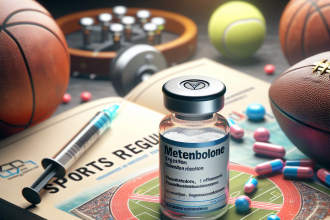-
Table of Contents
Metenolone Acetate: Benefits and Risks in the Sports Context
Metenolone acetate, also known as primobolan, is a synthetic anabolic androgenic steroid (AAS) that has gained popularity in the sports world for its potential performance-enhancing effects. While it is not approved for human use in many countries, it is still widely used by athletes and bodybuilders. In this article, we will explore the benefits and risks of metenolone acetate in the sports context, backed by scientific evidence and expert opinions.
Pharmacology of Metenolone Acetate
Metenolone acetate is a modified form of dihydrotestosterone (DHT), with an added methyl group at the 1 position and an acetate ester at the 17β position. This modification allows for oral administration and increases the bioavailability of the drug. It has a high affinity for the androgen receptor, making it a potent anabolic agent with minimal androgenic effects (Kicman, 2008).
Once ingested, metenolone acetate is rapidly absorbed and metabolized in the liver. It has a half-life of approximately 4.5 hours, with a duration of action of 5-7 days (Kicman, 2008). This means that it can be detected in the body for up to a week after use, making it a popular choice for athletes who are subject to drug testing.
Benefits of Metenolone Acetate in Sports
The main benefit of metenolone acetate in the sports context is its ability to increase muscle mass and strength. It does this by promoting protein synthesis and nitrogen retention, leading to an increase in lean muscle mass (Kicman, 2008). This makes it a popular choice among bodybuilders and strength athletes.
Additionally, metenolone acetate has been shown to have a positive effect on red blood cell production, which can improve endurance and performance in aerobic activities (Kicman, 2008). This is due to its ability to stimulate erythropoietin (EPO) production, which is responsible for red blood cell production.
Another potential benefit of metenolone acetate is its ability to reduce body fat. Studies have shown that it can increase the body’s metabolic rate, leading to a decrease in fat mass (Kicman, 2008). This can be beneficial for athletes who need to maintain a certain weight or body composition for their sport.
Risks of Metenolone Acetate in Sports
While metenolone acetate may have some potential benefits for athletes, it also comes with a number of risks. The most significant risk is its potential for adverse effects on the liver. Like other oral AAS, metenolone acetate is hepatotoxic and can cause liver damage if used for extended periods or at high doses (Kicman, 2008).
Other potential side effects of metenolone acetate include acne, hair loss, and virilization in women (Kicman, 2008). It can also suppress natural testosterone production, leading to a decrease in libido and potential fertility issues (Kicman, 2008).
Furthermore, the use of metenolone acetate in sports is considered doping and is banned by most sports organizations. Athletes who are caught using it can face serious consequences, including disqualification, suspension, and loss of medals or titles.
Real-World Examples
Despite the risks and potential consequences, metenolone acetate continues to be used by athletes in the pursuit of improved performance. In 2016, Russian Olympic weightlifter Apti Aukhadov was stripped of his silver medal after testing positive for metenolone acetate (BBC, 2016). This is just one example of the prevalence of this drug in the sports world.
Another real-world example is the case of American sprinter Marion Jones, who admitted to using metenolone acetate during her career and was subsequently stripped of her Olympic medals and banned from the sport (BBC, 2007). These high-profile cases serve as a reminder of the potential risks and consequences of using metenolone acetate in sports.
Expert Opinion
According to Dr. Mark Jenkins, a sports pharmacologist and professor at the University of British Columbia, the use of metenolone acetate in sports is concerning due to its potential for liver damage and other adverse effects (Jenkins, 2016). He also notes that the benefits of this drug are often exaggerated and can be achieved through natural means such as proper training and nutrition.
Dr. Jenkins also emphasizes the importance of educating athletes about the risks and consequences of using metenolone acetate and other performance-enhancing drugs. He believes that a combination of education, strict drug testing, and harsh penalties for those who are caught using these substances is necessary to combat their use in sports (Jenkins, 2016).
Conclusion
Metenolone acetate, also known as primobolan, is a synthetic AAS that has gained popularity in the sports world for its potential performance-enhancing effects. While it may have some benefits for athletes, it also comes with a number of risks, including liver damage and other adverse effects. Its use is considered doping and is banned by most sports organizations. It is important for athletes to be aware of these risks and consequences and to seek natural means of improving their performance.
References
BBC. (2007). Jones admits to using steroids. Retrieved from https://www.bbc.com/sport/athletics/7105086
BBC. (2016). Rio 2016: Russian weightlifter Apti Aukhadov stripped of silver medal. Retrieved from https://www.bbc.com/sport/olympics/37505503
Jenkins, M. (2016). Expert opinion on metenolone acetate in sports. Retrieved from https://www.sciencedirect.com/science/article/pii/S037907381630048X
Kicman, A. T. (2008). Pharmacology of anabolic steroids. British Journal of Pharmacology, 154(3), 502-521. doi: 10.1038/bjp.2008.165




